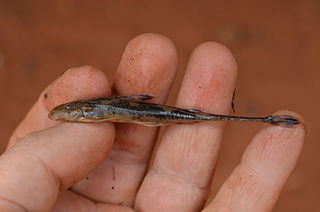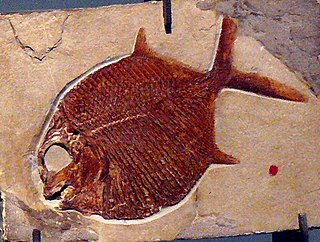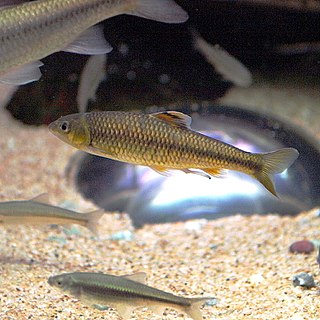
Phoxinus is a genus of freshwater fish in the family Leuciscidae of order Cypriniformes, and the only members of the subfamily Phoxininae, or Eurasian minnows. The type species is Phoxinus phoxinus. The other species in this genus are also commonly known as minnows. The name "minnow" was what early English fisherman used to describe "small and insignificant". The genus Phoxinus is found throughout Eurasia, and includes 21 known species. Previously, members of the North American genus Chrosomus were also believed to form part of this genus.

Glyptothorax is a genus of catfishes order Siluriformes of the family Sisoridae. It is the most species-rich and widely distributed genus in the family with new species being discovered on a regular basis. These species are distributed in the Black Sea basin, northern Turkey, south and east to the Yangtze River drainage in China and south throughout Indo-China to Java, Indonesia. They are found in Asia Minor and southwards to Southeast Asia. The genus is very diverse in the Indian subcontinent. Southeast Asian species tend to have restricted distributions.
Jean-Jacques Dussumier (1792–1883) was a French voyager and merchant from Bordeaux. He is known as a collector of zoological species from southern Asia and regions around the Indian Ocean between 1816 and 1840. These collections were later studied and classified by French zoologists such as Georges Cuvier, Achille Valenciennes, among others.

Tanakia is a genus of cyprinid fish, consisting of five species that occurs in Eastern Asia. The type species is the Tanakia limbata.

Hemibagrus is a genus of catfishes of the family Bagridae.
Leiocassis is a genus of bagrid catfishes found mostly in Southeast Asia with some species occurring in China.

Pelteobagrus is a genus of bagrid catfishes found in eastern Asia. The taxonomy of this genus is unclear and many authorities treat it as a junior synonym of Tachysurus and the type species of the genus, is Silurus calvarius which is a synonym of Tachysurus fulvidraco.

Pangasius is a genus of medium-large to very large shark catfishes native to fresh water in South and Southeast Asia. The term "pangasius" is sometimes used to specifically refer to the commercially important basa fish, P. bocourti.

Silurus is a genus of catfishes native to Europe and Asia.

Phractura is a genus of loach catfishes that occur in Africa.

Doumea is a genus of loach catfishes native to Africa.

Arius is a genus of catfishes of the family Ariidae. The genus Arius is distributed in brackish and fresh waters of Eastern Africa and south to Southeast Asia.

Pycnodontiformes is an extinct order of primarily marine bony fish. The group first appeared during the Late Triassic and disappeared during the Eocene. The group has been found in rock formations in Africa, Asia, Europe, North and South America. They were small to middle-sized fish, generally with laterally-compressed deep bodies, some with almost circular outlines, adapted for manuverability in reef-like environments, though the group was morphologically diverse. Most, but not all members of the groups had jaws with round and flattened teeth, well adapted to crush food items (durophagy), such as echinoderms, crustaceans and molluscs. Some pyncodontiformes developed piranha like teeth used for eating flesh. Most species inhabited shallow marine reef environments, while a handful of species lived in freshwater or brackish conditions. While rare during the Triassic and Early-Middle Jurassic, Pycnodontiformes became abundant and diverse during the Late Jurassic, exhibitng a high but relatively static diversity during the Early Cretaceous. At the beginning of the Late Cretaceous they reached their apex of morphological and species diversity, after which they began to gradually decline, with a more sudden decline at the end of the Cretaceous due to the collapse of reef ecosystems, finally becoming extinct during the Eocene. They are considered to belong to the Neopterygii, but their relationship to other members of that group is uncertain.

Hemibarbus is a genus of cyprinid fish found in eastern Asia. There are currently 12 recognized species in this genus.

Sarcocheilichthys is a genus of cyprinid fishes found in eastern Asia. There are currently 12 species in the genus.

Squalidus is a genus of cyprinid fish that occurs in eastern Asia. There are currently 14 described species in this genus.

Hemiarius is a genus of sea catfishes found in the coastal waters, estuaries, and rivers from South Asia through New Guinea and Australia to Oceania. Four described species are in this genus:
Pseudolais is a genus of shark catfishes native to Southeast Asia.















